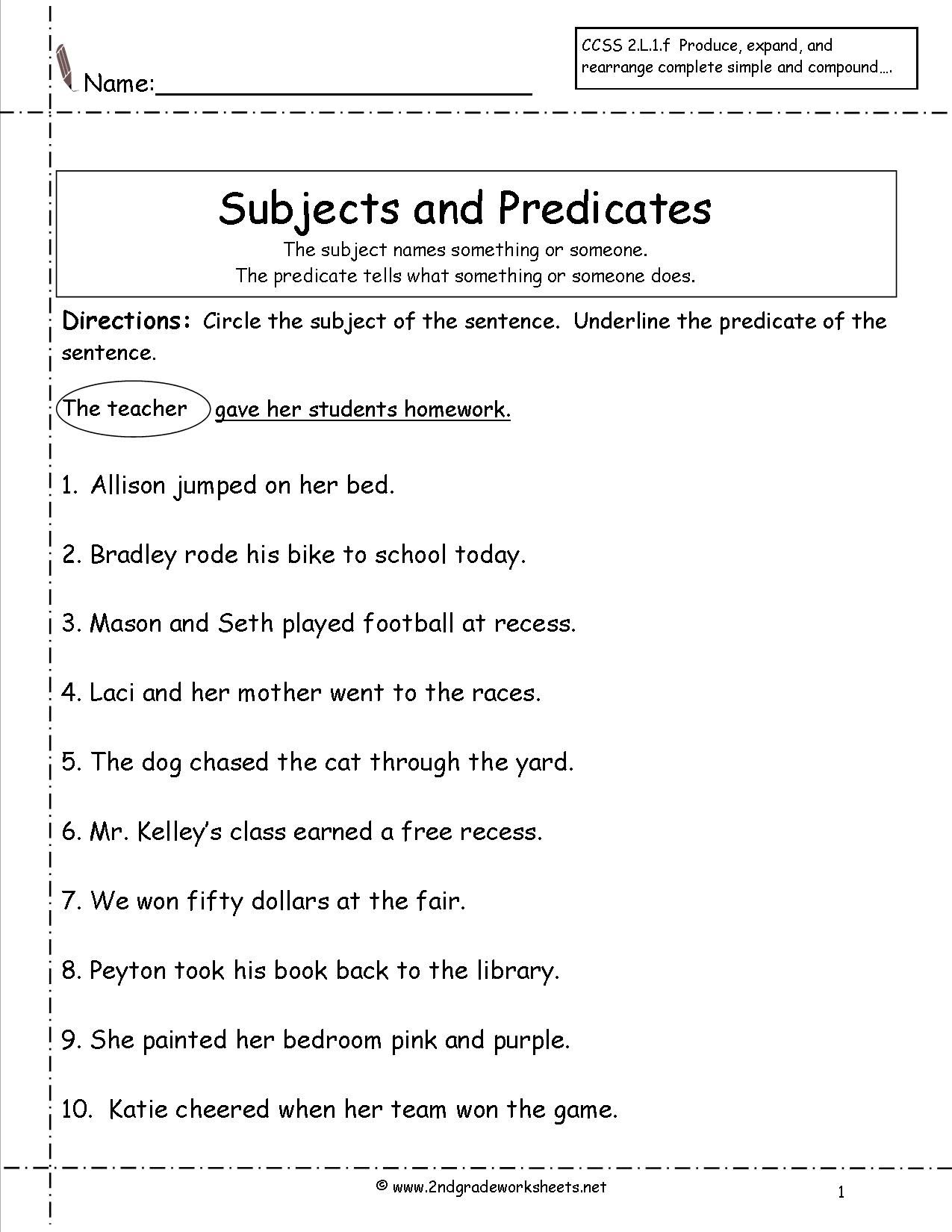Subject and Predicate Worksheet: Master Your Grammar Skills

Mastering grammar can seem like a daunting task, but understanding the basic building blocks of sentences can significantly enhance your writing and speaking abilities. In this blog post, we'll dive deep into one of the most fundamental components of grammar: the subject and predicate. By the end of this article, you'll have a comprehensive understanding of how these elements interact within sentences, and you'll be equipped with practical exercises to solidify your knowledge. Let's get started!
The Basics of Subject and Predicate

Every complete sentence consists of at least two parts: the subject and the predicate. Here’s what you need to know:
- Subject: This is the person, place, thing, or idea that the sentence is about. It is who or what is performing the action or being described.
- Predicate: This part of the sentence tells us something about the subject. It includes the verb and can include objects, modifiers, and other complements that provide information about the action or state of being described.
Here are some examples:
- In the sentence "The cat sleeps on the windowsill."
- Subject: The cat
- Predicate: sleeps on the windowsill.
- In the sentence "Jane runs a mile every morning."
- Subject: Jane
- Predicate: runs a mile every morning.
Understanding Simple Sentences

A simple sentence contains just one independent clause. Here, the structure of subject and predicate is straightforward:
- Subject: Singular noun or pronoun.
- Predicate: Contains a single verb.
Example:
- "The dog barks."
📝 Note: In sentences where the subject is implied, as in commands like "Stop!" or "Go away!", the subject is understood to be "you."
Expanding to Complex Sentences

As sentences grow more complex, the structure becomes more intricate:
- Compound Subjects: When two or more subjects share the same predicate.
- Compound Predicates: When a subject has more than one verb, each describing different actions or states.
- Compound Sentences: Two or more independent clauses, usually joined by coordinating conjunctions like 'and', 'but', 'or'.
Examples:
- Compound Subject: "James and Sarah play tennis every weekend."
- Compound Predicate: "The bird chirped and flew away."
- Compound Sentence: "Marie washed the dishes, and then she mowed the lawn."
Practical Exercises

To master the distinction between subjects and predicates, try these exercises:
- Identify the Subject: Underline the subject in the following sentences:
- Jennifer loves reading books on her Kindle.
- Cars drive past our house all night.
- The teacher explained the lesson very well.
- Create Your Own Sentence: Make up sentences where the subject is:
- A non-living object.
- A group of animals.
- An idea or concept.
- Expand the Predicate: Add more detail to the following sentences:
- The cat sleeps. → The cat sleeps on the couch during the day.
- The car raced. → The red sports car raced down the highway at breakneck speed.
- He eats. → He eats a hearty meal of steak and potatoes every evening.
💡 Note: Always ensure your sentences have a clear subject to avoid fragments, which are incomplete sentences and can confuse readers.
Subject-Predicate Inversions

In certain cases, the usual subject-predicate order is reversed for emphasis or style:
- Questions: "Can you believe it?" (Here, "you" is the subject, and "can believe it" is the predicate).
- Emphatic Sentences: "Off the bed he jumped!" (The subject "he" follows the predicate for dramatic effect).
- Interrogative Statements: "What a beautiful morning it is!" (Here, the subject comes after the predicate).
Why Understanding Subject and Predicate Matters

The distinction between subjects and predicates is not just academic; it has practical applications:
- Clarity: Clear delineation helps in constructing sentences that are unambiguous.
- Effective Communication: A well-formed subject and predicate can enhance the impact of your message.
- Writing Style: Mastery over these components can influence your writing style, making it more engaging or persuasive.
- Error Reduction: Understanding subject-predicate relationships reduces grammatical errors, particularly subject-verb agreement issues.
Summary

In this exploration of subjects and predicates, we've covered:
- The basic definitions and examples of subjects and predicates.
- How these elements function in simple, compound, and complex sentences.
- The importance of understanding these grammatical structures for clarity and effective communication.
- Practical exercises to help you master these concepts.
By now, you should feel more confident in identifying and utilizing subjects and predicates in your writing. Remember, practice is key to mastery, so continue to engage with grammar exercises, read widely, and write often. The more you immerse yourself in the language, the more intuitive these structures will become.
What is a compound subject?

+
A compound subject is when two or more subjects are connected by a conjunction like ‘and’, ‘or’, or ‘nor’ and share the same predicate. For example, “Tom and Jerry chase each other.”
Can a sentence have more than one predicate?

+
Yes, a sentence can have multiple predicates, making it a compound predicate. For instance, “The dog barked loudly and chased the cat.”
How can I identify the subject in a sentence?

+
Ask yourself, “Who or what is this sentence about?” The answer to that question is generally the subject. If you can replace the word with ‘he/she/it/they’ and the sentence still makes sense, you’ve likely identified the subject correctly.